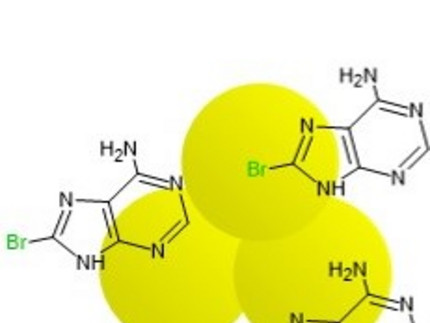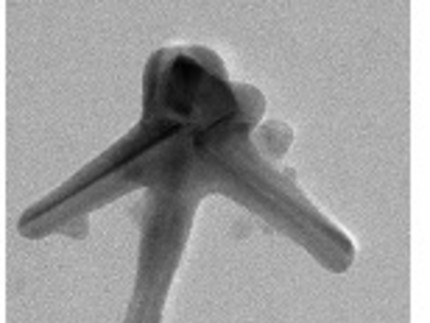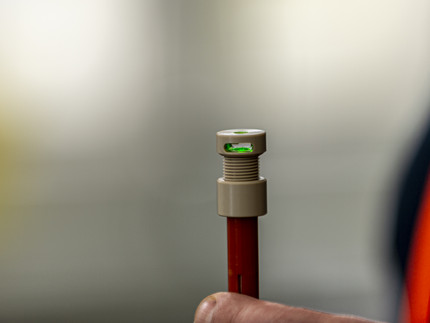Looking Deeper with Rare Earth Nanoparticles
Under the direction of apl. Prof. Dr. Michael Kumke (RG Physical Chemistry), a user-oriented adaptation of a modular platform for frequency-converting nanopartciles (UCNP) is being worked on, consisting of: i) a biocompatible UCNP (immobilized in solution or on surfaces) as an optical transducer and ii) a portable readout unit (NIR laser diode, detection via smartphone and/or photodiode) for mobile use in life and environmental sciences.
Download Transfer Offer 23-06 (PDF, 523 KB)
Influence of nanoparticle size on plasmon-induced reactions
The research work of Christina Beresowski from the Colloid Chemistry group headed by Prof. Dr. Ilko Bald deals with plasmon-induced reactions caused by the excitation of nanoparticles and the associated generation of so-called "hot electrons". In particular, the size effect of the plasmonic nanoparticles on the reaction kinetics is investigated. For this purpose, the molecules to be studied must adsorb on the surface of the nanoparticles. In the next step, the functionalized nanoparticles are dropped onto a silicon wafer, where they aggregate after subsequent drying. Surface-enhanced Raman spectroscopy (SERS) is used to induce and simultaneously follow the reaction.
Download Transfer Offer 23-04 (PDF, 606 KB)
Optical Fiber Sensors
The FöWiTec-funded project of the Functional Materials group of Dr. Claudia Pacholski deals with the fabrication of tailored optical fiber sensors and investigates both their chemical and optical properties. The work focuses on equipping the fiber tips with nanomaterials, such as porous silicon and stimuli-responsive polymers. The porous silicon is generated by electrochemical or metal-assisted etching, and both the pore size and the optical response of the material are freely adjustable. By combining the porous material with polymers, optical fiber sensors can be produced to precisely fit a targeted application.
Download Transfer Offer 23-01 (PDF, 624 KB)
Applied Optical Sensors and Spectroscopy
The working group Applied Optical Sensors and Spectroscopy of apl. Prof. Michael Kumke focuses its research on lanthanides, which are used as luminescence probes in the life and environmental sciences as well as in clinical diagnostics in down shifting and frequency upconversion applications. In case of frequency upconversion, the electromagnetic radiation required for excitation is in the NIR range. In this area, water and other biological materials show only a low intrinsic absorption. Therefore, the potential for optically-based sensors with applications in the life and environmental sciences is outstanding. Special attention is hereby payed to the production of novel lanthanide-containing nanoparticles whose surface is modified with biomarkers. Other ongoing research projects include bio-inspired filter materials for lanthanide recovery, physico-chemical processes in the near and far field of repositories, nanoparticles for SOEC/SOFC applications, and the remote detection of leaks in hydrogen lines.
Download Transfer Offer 21-10 (PDF, 676 KB)
Hybrid Nanostructures
The research of the working group Hybrid Nanostructures under the leadership of Prof. Ilko Bald combines different methods from DNA nanotechnology, optical spectroscopy and scanning probe microscopy in order to study physico-chemical processes at the single-molecule level. The aim is to develop novel analysis methods for their application in different fields, such as the precise with nanomaterials. Apart from methods diagnostics using optical fibers modified development, specific questions such as nucleotide sequence dependence of DNA radiation damage and the mode of action of radionsensitizers that are applied in tumor radiation therapy are being investigated. Furthermore, chemical processes on the surface of plasmonic nanostructures that are triggered by electron transfer are analysed.
Download Transfer Offer 21-03 (PDF, 356 KB)
Superstructures with nanoparticles of defined shape and size
The research group of Prof. Joachim Koetz is dealing with the synthesis of nanoparticles of different shape and size and their application as sensor materials and for the surface- enhanced Raman spectroscopy for the detection of molecules and reaction mechanisms. The important thing here is the separation and isolation of anisotropic nanoparticles (nanotriangles and nanostars) and their surface modification. In addition to the self- organization of gold and magnetite nanoparticles, the research is focused on the insertion of these particles into Janus emulsions. This makes it possible to adjust the droplet size of stimuli-sensitive Janus emulsions, and respectively the pore sizes of the resulting aerogels. The ultralight magnetic aerogels can be used for purifying liquids (dye and oil layer separation).
Dowload Transfer Offer 21-02 (PDF, 15,3 MB)
Chemical Strategies for Functional Nano- Structures
The research group Functional Materials of Dr Claudia Pacholski aims to fabricate materials with new and exciting properties, that can later be used as optical sensors. The scientists of the group synthesize nanomaterials and investigate their chemistry as well as their optical properties. A special focus is on the preparation and self-assembly of inorganic nanomaterials in combination with polymers.
The team uses various methods and is interested in different areas of application. For example, through the action of energy new nanomaterials or nanostructures with unusual structural, electrical, optical or magnetic properties and functionalities can be generated. These form the basis
for the development of new materials and sensors.
Download Transfer Offer 21-01 (PDF, 520 KB)
SensreD
With its expertise in photochemistry, laser spectroscopy, optical sensor technology and photophysics, the Physical Chemistry team at the University of Potsdam is active in basic and applied research. SensreD, a sensor system with functionalised optical waveguides for respiratory diagnostics, is an example of an interdisciplinary project with high application potential in medical diagnostics. The optical sensor for continuous respiratory gas analysis, developed jointly with the Chair of Sports Medicine and Sports Orthopaedics, is intended to improve the comfort of spirometric measurements for test subjects. On the other hand, the design and sensitivity of the prototype harbour potential for a wide range of applications, which should be developed in future research projects.
The document is only availeble in German. (PDF, 516 KB)
Nanometer-scale imaging and measurements: Atomic Force Microscopy and Kelvin Probe Force Microscopy
The research team of Prof. Dr. Regina Hoffmann-Vogel, the Professor of Experimental physics of condensed matter at the University of Potsdam, aims to understand the relationship between atomic and mesocopic structures as well as electronic transport in nanostructures. To investigate these nanostructures, the research team uses atomic force microscopy and Kelvin probe force microscopy to conduct nanometer-scale imaging and measurements. To date, the group has successfully collaborated with several academic and industrial partners throughout Europe.
Download Transfer Offer 20-05 (PDF, 552 KB)









